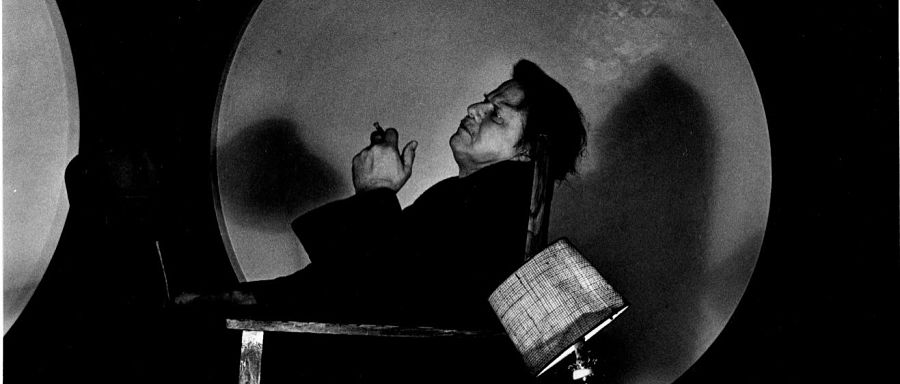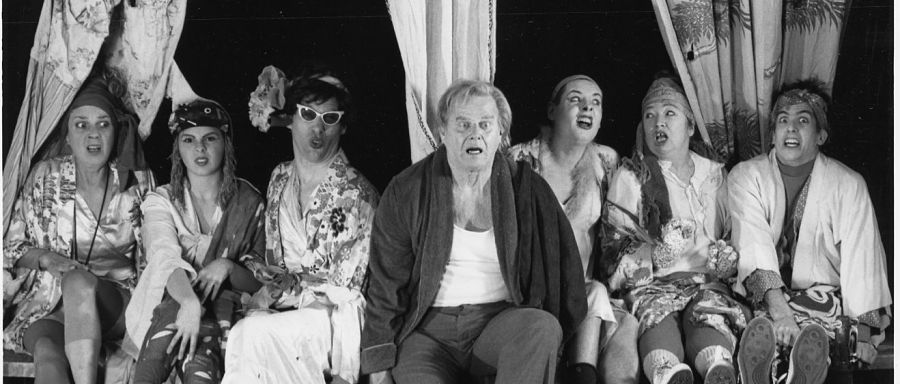Path-breaking director and Mabou Mines co-founder Lee Breuer died on Jan. 3. He was 83. Another memorial tribute to Breuer can be read here.
Lee had muses—many muses. Let me tell you how it was. Fred Neumann, Lee would tell me, was his voice. Equal parts Balzac, Orson Welles, Nietzsche, and a rough man he knew from the cold North, Lee wrote and Fred spoke: one voice. Body and song, like Noh theatre. David Warrilow said that his work with Lee on The Lost Ones was making love. Not the metaphor, not the magical as if—no, David said with his steady gaze, it was for him the thing itself. Those rehearsals were the most tender I had ever seen. That both David and Fred became major interpreters of and personal friends with Samuel Beckett was, I think, inevitable. Luck had nothing to do with it. Lee did.
No one wanted to be comfortable with what they already knew. Bill Raymond inspired and provoked Lee like a mirror to go as far as he could go with A Prelude to Death in Venice, his most mercurial piece, a deadpan romp that pulled you willingly across the border into comic confessional surrealism.
The combination of intimacy, agency, and freedom, but especially agency, was how Lee worked. In the words from The Red Horse Animation, he gave the performer “some form to hold me.” He wrote for us. He asked me if I could turn Tina Girouard’s curtain for the set for B. Beaver into a puppet, and make her art work dance, and there began the age of puppetry for Mabou Mines, my curtain choreography. Lee, along with JoAnne Akalaitis and Ruth Maleczech, Fred and Bill, would come to the company with a conceit for the next new work, and we all worked within those bounds. The foundational company was like the Ellington band, composed of directors who performed, and radical ideas. We were confident that if we stuck true to that, we would find our audience or die trying. I tell you, for years it was touch and go.
Others will say—and it is certainly true—that Lee detested limitations. I will say his greatest fictions were his budgets. Crisis was a muse. In 1978, when our survival was at its most uncertain, we put together a studio in a squat on Ninth Street and First Avenue that saved us. We commandeered rooms in cooperation with Mark Russell and other artists that meant that no one could kick us out because it was getting late. We put up scaffolding around the building so developers would think the structure was falling down when it wasn’t, and they passed us by like a storm. We soundproofed the windows and Philip Glass recorded the music for Company there. There was only enough electricity to have about five theatre lights on at a time, never enough heat in the winter, and not even the dream of cool air in the summer.

There, and for the eight years previous to that, we made great works. It was vision or extinction. In Lee’s words, spoken by Fred Neumann in the B. Beaver, it was “mutate or face your fate.” The pieces were about our condition, desired community, and the theatre we wanted to see. People who hated theatre loved the B.Beaver. New York poets passed glances to one another, dancers checked their breath seeing The Red Horse, racing, chanting, breaking apart.
Lee’s writing was there to astonish and run away from you. You had to sprint to keep up with him; this was intensely physical theatre. Musicians ran our lights. Sculptors made our sets. Ellen Stewart gave us a way with open arms and our first home; Joe Papp gave us our second. Through all of this Lee was impatient, relentless, and loyal to the place where the real work could be done, and to the crazy idea that you could make something that would endure.
Before Lee had a MacArthur genius grant, he had something far more important: a line of credit at the local bodega on Avenue A. He said with that he knew he had made it. In those days he had hair, cigarettes were 25 cents a pack, and he literally cut and pasted typed-out printouts of his words with a scissors and glue stick, editing his texts in the way our idol Jack Smith edited and reedited his films. Sometimes, and this is true, he would give you a new speech, still sticky or written flat out in pencil, at intermission. He invented Porco, put Joe Stalin in the room, and had Fred play out the death of Meyerhold, and put me a few scenes later dancing on the table, marrying tango and bunraku.
He could be satori. When Ruth Maleczech, Black-Eyed Susan, and I were near completion with our rehearsals of The Bribe, Lee came in and gave the image of Chinese clowns, showing us, as the actor that he was, a time-tested physicality which was urgent, conspiratorial, and no less naturalistic than the words. It clicked, elevating in one kick the text, John Zorn’s music, and the terrifying voice of Jeff Weiss, channeled through the body of six-foot-tall drag queen Lily of the Valley (the brilliant Michael Cavadias).
When Lee took over direction of Animal Magnetism in 1999, he did so with one word: “Songs.” Rehearsals at Sundance Theater Lab were fast cooking as a stir fry, and before we knew it, we had 40-plus people sitting in on our rehearsals. It was there that Lee and Maude met, as Lee, Robin Lorentz, and I hammered and banged out songs based on my raw pages and Eve Beglarian’s brilliant score. The greatest compliment came from the horn player, Bohdan Hilash, who said it was like being in a really good band.
I’ll leave you with this.
Lee and I shared a room in Krakow in 2003. I was doing advance work for our show Animal Magnetism and he was working with Projekt Theater, a company we both knew. I had directed an Endgame with them in 1999, and on this occasion, he was working on an original text by the artistic director. It was a gig, assignment theatre, and he went all out. Being with him was like living with a monk working on a sacred text. Living in a clean, neutral room, a no-frills hotel in Krakow, he pored over a battered paperback copy of A Doll’s House, making notes all over the pages with a Bic pen, drilling down, bringing out the life of the undertext, hearing the pauses, pulling off the insulation, her story, his story, dreaming grief and cause for grief—it was devotion beyond the reach of reason, laid painfully, comically bare in a conceit that came from Bertolt Brecht, and a wig thrown in rage to the floor. He channeled Charles Ludlam with that move, and the shock hit our soul as the wig hit the floor. That moment was the end of the play, but Lee showed us patiently the rest of the story and carried us out with it, a figure at a distance walking out through a doorway pursued by a question.
If you can feel the catharsis of Gospel at Colonus and still be touched by Nora’s plea, if you can see Wendy’s flights with the lost boys, Basil Twist’s Peter in Julie Archer’s sets and hear the Irish airs, if you can see as I see David and JoAnne and Ruth in The Red Horse, see the eyes of Hajj, Lear in the storm, Karen Kandel as Mad Marie Laveau conjuring on the bare stage to save her mother’s life, this and the racing heart of Red Beads and that fast-talking man in A Prelude to Death in Venice, you will have a window into some of the parts of all that lived within this man, my friend, who we all have just lost.
You should know Lee was working almost to the end. In November he arranged to premiere Horton Foote’s A Coffin in Egypt in Savannah, Ga., for March/April, and further forward, he was continuing the work already well underway on a new translation of Medea, that would open next year should time, the fates, and this plague allow.
Terry O’Reilly (he/him) is a playwright, performer and director. He has been co-artistic director and writer-in-residence with Mabou Mines since 1972. 2022 will be his 50th year with the company.


